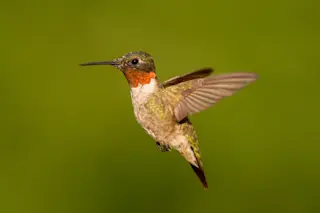(Credit: Jack Dean III/Shutterstock) Ruby-throated hummingbirds are impressive birds. On average, they beat their wings 52 times per second. They can can reach flight speeds of up to 63 mph to evade danger. They're also endurance flyers. Every fall, ruby-throated hummingbirds make the long flight from the eastern U.S. to Central America to winter in warmer climates. And they may cover greater distances than previously thought, according to a new study which also sheds some light on how young hummingbirds handle the challenges of their first migration. When it comes time for their annual winter migration, these birds will start beating their wings and they won't stop until they've covered some 1,300 miles — not bad for a bird that weighs as much as three paperclips.
Ruby-throated hummingbirds are the only hummingbird species that breeds in the eastern U.S., and biologists still don’t know much about their migration habits. It’s ...














